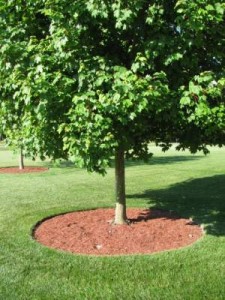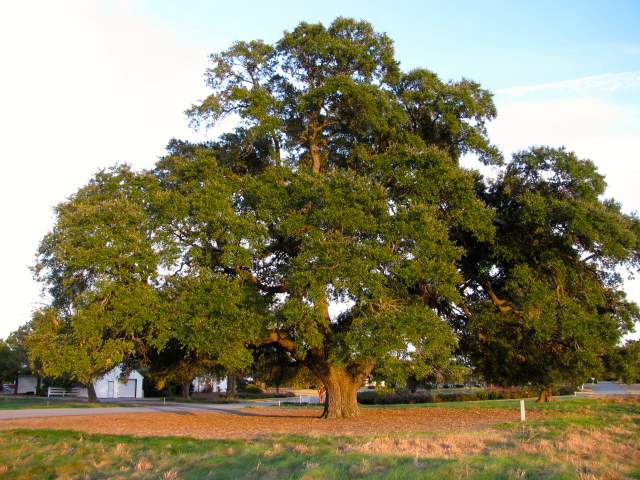Proper mulching technique will enhance the appearance of your property and significantly improve the health of your trees. Trees and turf compete for the same water and nutrients. By eliminating competition with turf grass and weeds, trees roots will have more access to water and essential elements. Additionally tree roots will be denser in the upper soil layer where oxygen is more plentiful. As the mulch decomposes, organic material will improve soil fertility and promote good soil structure. Proper mulching is essential if you want healthy, beautiful trees.
Types of Mulch

Proper mulching technique
go wide, not deep
There are two main classes of mulch, organic and inorganic. Inorganic mulches are used occasionally and include pea gravel, rocks, crushed stone, brick chips, and shredded rubber. Although inorganic mulches can be attractive in some situations, I don’t usually recommend them because they lack important ecological benefits that organic mulches provide.
The most common organic mulches include leaves, pine straw, bark, and wood chips. If you’re fortunate to have mature trees on your property, consider using the mulch that’s being delivered for free every autumn. Pine straw makes an excellent mulch as do leaves that decompose rapidly. However not all decompose quickly such as some species of tannin-rich oak or sycamore leaves. Walnut leaves should also be avoided because they contain juglone, a harmful compound to many plants. Generally I don’t recommend using grass clippings as a mulch, especially if herbicides have been applied to the lawn.
Proper Mulching
In a nutshell, go wide, not deep. Apply the mulch at least 2 inches deep, but no more than 4 inches deep. Don’t allow the mulch to touch the tree trunk, but spread the mulch out as wide as practical. I recommend mulching out to the drip line whenever circumstances will allow. The most common mistake to avoid is the ubiquitous “mulch volcano”. The bane of trees everywhere, “mulch volcanoes” create poor growing conditions for the trunk and roots and can contribute to insect and disease problems.
You can always call or email us for free wood chips to use as a base layer, but it’s important to remember that raw wood chips are generally not as attractive as commercially available mulches.
Many home owners are dissuaded from creating large mulch rings because they believe it’s not aesthetically pleasing. However, I would suggest this view is a cultural artifact, based not on tree health or sound environmental considerations, but perhaps on the imprudent stylistic prejudices of neighboring landscapes.
The impressive tree pictured below, a stately and splendid specimen of live oak, stands at the entranceway to Bayville Golf Club here in Virginia Beach. Even on a prestigious golf course, where turf grass suitably reigns supreme, the caretakers of this magnificent tree understand the benefits of proper mulching. Notice how the tree’s root flare is clearly visible, indicating the mulch is not too deep, nor piled harmfully against the bark.

Proper mulching technique for a mature live oak
Of course there are practical size limitations for mulch rings in our landscapes and not all mulch rings can extend to the drip line, especially for broad, mature trees. However it is usually possible to extend mulch rings to 10 – 15 feet, which will reduce competition from turf grass, improve soil structure and fertility, increase the density of fine absorbing roots near the surface, and improve the health and beauty of your trees.
As we become more environmentally aware, the unnatural and conventional lawn- centered landscape will recede and our native trees of the Virginia Coastal Plain will be given the landscape primacy they previously held when Europeans first sailed into the Chesapeake Bay. Help make it so by using proper mulching techniques whenever practical.
